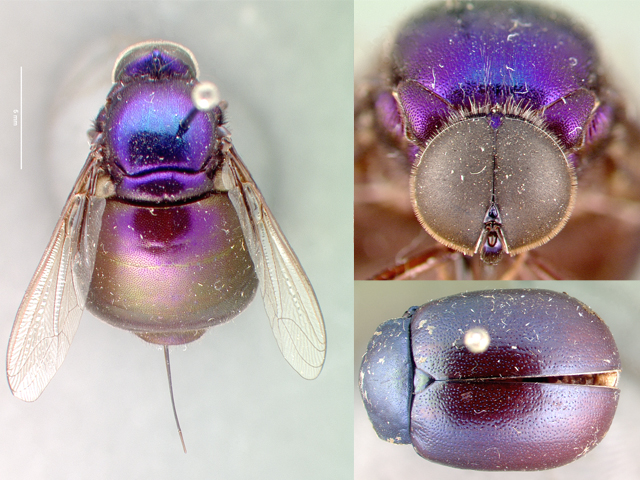 Glass klettii: April Nobile per Photos, CAS
Glass klettii: April Nobile per Photos, CAS
Nam magna ex parte, non mihi nimis excitatur circa an insect. Autem, aenigmaticam Acroceridae sunt familiae exceptis. Ego committitur communicansque aliquam interdum interesting genera – procul dubio mirabilis est diversum genus. Most of my days are spent at the museum inventorying our massive collection of over 16,000 Acorcerids (aka small-headed flies). That may not sound all too impressive when you compare it to other more abundant families (and it does pale in comparison to the over 17,500,000 other specimens we do have in the museum); but it turns out to represent many, if not most, autem omnes known specimens for the entire family. While there are likely large assemblages of these flies in other institutions, the California Academy of Sciences can easily claim the record ever since receiving the collection of Dr. Evert I. Schlinger (who occasionally comes in to work from the museum).
Acrocerids turn out to be a rather difficult group to study because of how rare they are in nature, their parasitoid biology, quamque aegre cornu capere possint?. Thorax magna eorum est referta musculis, qui erucae volant per aerem – sic, si in flore capis, desiderium Malaise laquei relictus es. Homilia mihi narravit unam fabulam discendi has capere in ala in Costa Rica .. Vos a collega in agro sistitis – quam primum aliquis audit aliquid praeteritum zip, tu oscilla sperans laqueum musca forte… omne opus facit semel in tempore. Hae muscae solae notae sunt endoparasitae araneorum adultorum (potest esse memoria Tachinid…). Genus superius, NeoLasia, est parasitus Theraphosid tarantulas (aliquid simile Aphonopelma). As a larvae the fly works its way up the legs of a spider and burrows into the abdomen where it then settles in next to the book lung and pokes a little breathing hole. Then it waits patiently for the spider to near maturity. With female tarantulas, the fly could be dormant for decades. Eventually something akin to the movie Aliens happens and the larvae feeds on the internal organs of the spider then emerges to pupate. But figuring out whether or not a spider has a parasite is impossible without a dissection – so large collections of live spiders must be maintained to obtain host records. Parasitoid biology is just so cool.
The above specimen (Glass klettii a new, unnamed, species) was collected in 1977 by Schlinger near the town of Alamos, Mexicum – on flowers with the likely mimic model, a Chrysomelidae beetle (beetle people, aliqua notiones ultra familiam?).

Very interesting! Out of curiosity, because you mention large collections of live spiders, has any researcher reached out to the hobby tarantula keepers in a quest for specimens? While I have never seen something as spectacular as the above emerge from a wild caught tarantula, I have heard from a few people who ended up with “strange” flies in the past…
Reaching out to them for actual tarantulas has lead to quite a few specimens for Brent Hendrixson on his revision of the genus Aphonopelma, at least for the USA native species. There also are frequently imports of various species brought in from Central and South America, which is not a practice I like or am comfortable with…but it might lead to at least a few specimens given the numbers involved. Just a thought.
I think the answer is somewhat. I’ve reached out on message boards and even recently gave a short talk to the SF Bay Area Tarantula Society. The problem comes down to peoples immediate response when they see a giant grub crawling out of their spider – they reach in and grab their prize specimen and in the process damage the larvae or pupae of the emerging fly. As it turns out these flies are pretty sensitive before pupating and while I’ve seen lots of maggot images, never seen a fly reared by a hobbyist. I think the biggest hurdle is that people only discover what they are after they have had a spider die – and chances are it’ll be years before another one of their wild caught immature spiders are parasitized!
That makes a lot of sense, I guess it didnt really occur to me that for most people having a parasite emerge from one of their captives is a bad thing…that sort of thing would make my day. 🙂
Especially if that spider cost you a few hundred dollars!!
I wonder if that fly sees very well. 🙂
First impression of the beetle is a species of Chrysolina (subfamily Chrysomelinae), but my knowledge of Neotropical chrysos is limited.
Thanks for the genus ballpark – I’ll have to dig through our collections here to see if I can’t narrow it down more.
Did you mean that these acrocerid flies are the only known dipteran endoparasites of adult spiders? There are certainly spider-parasitic nematodes, and mantidfly larvae can crawl into the book lungs of their spider hosts and feed on hemolymph while hitching a ride to the egg deposition site.
http://en.wikipedia.org/wiki/Mantispidae
And here’s a cool post about a mantidfly larva on a spider, preserved in amber!
http://blogs.discovermagazine.com/notrocketscience/2011/03/28/spider-boarding-insect-preserved-in-amber/
(Certus, that one’s on the outside of the spider, but the post also has more info on other tactics.)
Thank you for pointing that out! You’re correct of course, when I was thinking “no other endoparasitoids” I totally neglected non-insects such as nematodes. I should have recalled how tricky it can be to control nematode infestations in captive bread spiders!
I also did not know that about mantidflies. Actually I should catch up on the literature, there may be other diptera or hymenoptera parasitoids more recently known. Very cool, thanks for the link.
Augh augh augh and here’s a picture of a huuuuuge nematode coming out of a spider! It’s even one of the behavior-modifying parasites — it induces its host to seek out water before dying, so the nematode can complete its life cycle. (Like the horsehair worm in crickets!)
http://www.abc.net.au/science/k2/stn/spider.htm